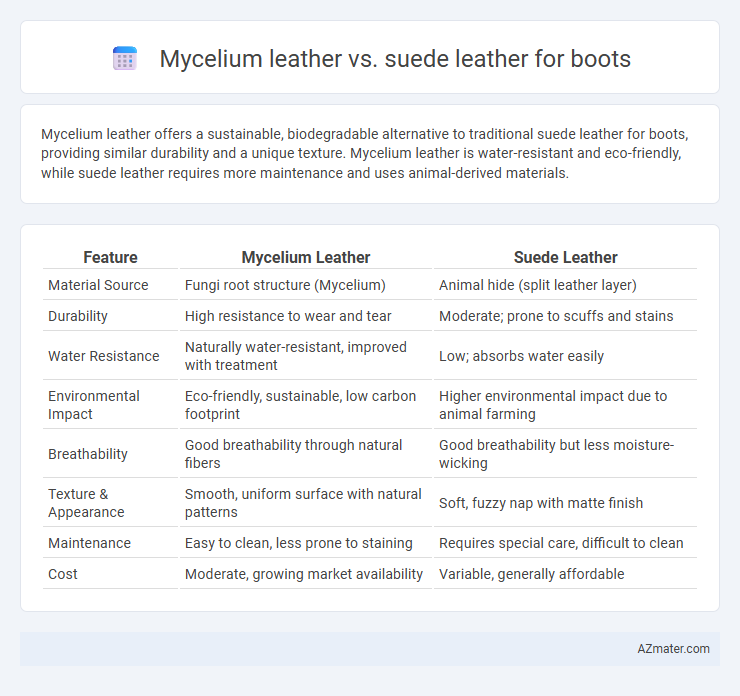Mycelium leather offers a sustainable, biodegradable alternative to traditional suede leather for boots, providing similar durability and a unique texture. Mycelium leather is water-resistant and eco-friendly, while suede leather requires more maintenance and uses animal-derived materials.
Table of Comparison
| Feature | Mycelium Leather | Suede Leather |
|---|---|---|
| Material Source | Fungi root structure (Mycelium) | Animal hide (split leather layer) |
| Durability | High resistance to wear and tear | Moderate; prone to scuffs and stains |
| Water Resistance | Naturally water-resistant, improved with treatment | Low; absorbs water easily |
| Environmental Impact | Eco-friendly, sustainable, low carbon footprint | Higher environmental impact due to animal farming |
| Breathability | Good breathability through natural fibers | Good breathability but less moisture-wicking |
| Texture & Appearance | Smooth, uniform surface with natural patterns | Soft, fuzzy nap with matte finish |
| Maintenance | Easy to clean, less prone to staining | Requires special care, difficult to clean |
| Cost | Moderate, growing market availability | Variable, generally affordable |
Introduction to Mycelium and Suede Leather
Mycelium leather, derived from the root structure of mushrooms, offers a sustainable and eco-friendly alternative to traditional suede leather, which is crafted from the underside of animal hides. Mycelium's natural fiber matrix provides durability and breathability while minimizing environmental impact through renewable cultivation. Suede leather, known for its soft texture and flexibility, is widely used in boots but involves resource-intensive animal farming and complex tanning processes.
How Mycelium Leather Is Made
Mycelium leather is created by cultivating fungal root structures, which are grown on controlled substrates and then processed into durable, flexible sheets that mimic traditional leather. Unlike suede leather, which is derived from the underside of animal hides and involves tanning and buffing, mycelium leather offers a sustainable, vegan alternative with a lower environmental footprint. This innovative production method reduces reliance on animal agriculture and chemical treatments typically associated with conventional suede leather manufacturing.
Traditional Production of Suede Leather
Traditional production of suede leather involves splitting cowhide or other animal hides and sanding the inner surface to create a soft, napped finish, a process that requires significant water, chemicals, and energy, leading to environmental concerns. Mycelium leather, derived from fungal root structures, offers a sustainable alternative with lower resource consumption and biodegradable properties, while maintaining a durable yet flexible texture suitable for boots. This innovation helps reduce the ecological footprint associated with conventional suede leather manufacturing in the footwear industry.
Sustainability and Environmental Impact
Mycelium leather, derived from fungal roots, offers a sustainable alternative to traditional suede leather by requiring significantly less water, land, and chemicals in production, thereby reducing carbon emissions and toxic waste. Suede leather, sourced from animal hides, involves intensive resource consumption and contributes to deforestation, methane emissions, and pollution through tanning processes. Choosing mycelium leather for boots supports lower environmental impact and aligns with eco-friendly fashion trends promoting biodegradability and reduced ecological footprints.
Durability and Longevity Comparison
Mycelium leather offers superior durability compared to suede leather due to its dense fiber network and natural resistance to wear and moisture. Suede leather, while soft and flexible, tends to show signs of aging such as scuffing and water damage more quickly, reducing its longevity in boot applications. The renewable nature of mycelium leather also contributes to lasting performance, making it a sustainable and resilient alternative in footwear.
Comfort and Breathability in Boots
Mycelium leather offers superior breathability compared to suede leather, allowing better air circulation and moisture wicking within boots, which enhances overall foot comfort. The natural, porous structure of mycelium material reduces heat buildup, making it ideal for extended wear in various climates. Suede leather, while soft and flexible, tends to retain moisture and heat, resulting in less breathability and potential discomfort during prolonged use.
Style, Texture, and Aesthetic Differences
Mycelium leather offers a unique, eco-friendly alternative to suede leather with a smoother yet slightly fibrous texture that enhances durability in boots. While suede leather provides a soft, velvety feel and classic matte finish favored for traditional styles, mycelium leather showcases a modern, natural grain pattern with greater customization in color and finish. Boots made from mycelium leather often project an innovative, sustainable aesthetic, contrasting with the timeless, luxurious appeal of classic suede boots.
Water Resistance and Care Requirements
Mycelium leather offers superior water resistance compared to suede leather, making it an ideal choice for boots exposed to wet conditions. Suede leather, derived from the underside of animal hides, absorbs water more easily and requires regular waterproofing treatments to maintain durability. Mycelium leather's low maintenance nature and natural resistance to moisture reduce the need for frequent care, whereas suede demands careful cleaning and conditioning to prevent damage.
Cost and Market Availability
Mycelium leather typically costs more than suede leather due to its sustainable production process and smaller-scale manufacturing. Suede leather benefits from widespread market availability and established supply chains, making it more affordable and easier to source for boots. Consumers often face limited options and higher prices when choosing mycelium leather boots compared to the more accessible suede alternatives.
Future Prospects for Mycelium vs Suede Leather Boots
Mycelium leather offers sustainable advantages and biodegradability that position it as a strong alternative to traditional suede leather in the footwear industry. Advances in mycelium leather technology promise enhanced durability, water resistance, and customizable textures, making it increasingly competitive for boots. Growing consumer demand for eco-friendly materials and stricter environmental regulations will likely accelerate the adoption of mycelium leather over conventional suede in future boot manufacturing.

Infographic: Mycelium leather vs Suede leather for Boot
 azmater.com
azmater.com